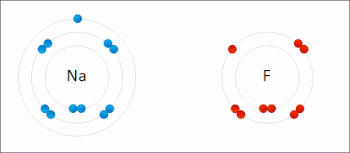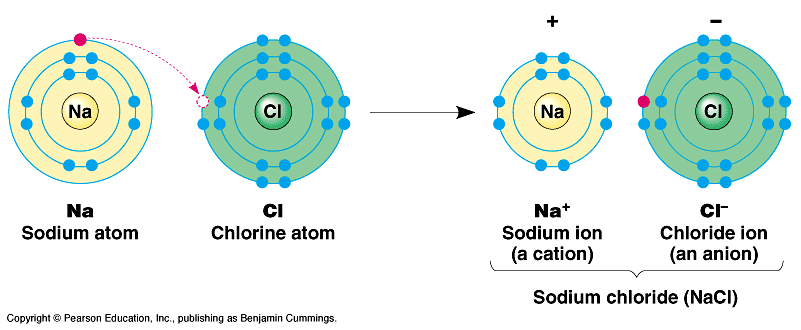Same number of valence electrons. Group 1: Li, Na, K, Rb, Cs, Fr Group 16: O, S, Se, Te, Po. Excited State 36 (e-have absorbed energy to move to a higher energy level).
- Na Electrons And Protons
- Na Electrons Per Shell
- Na Condensed Electron Configuration
- Na Protons And Electrons
- Na Electrons In Outer Shell
- Na Electrons Ion
Learning Objective
- Calculate effective nuclear charges experienced by valence electrons.
- The number of electrons in an electrically-neutral atom is the same as the number of protons in the nucleus. Therefore, the number of electrons in neutral atom of Sodium is 11. Each electron is influenced by the electric fields produced by the positive nuclear charge and the other (Z – 1) negative electrons in the atom.
- Chemistry Sodium atoms have 11 electrons, one more than the stable configuration of the noble gas neon. The first and second ionization energies are 495.8 kJ/mol and 4562 kJ/mol), respectively. As a result, sodium usually forms ionic compounds involving the Na + cation.
Key Points
- The shielding effect describes the balance between the pull of the protons on valence electrons and the repulsion forces from inner electrons.
- The shielding effect explains why valence-shell electrons are more easily removed from the atom. The effect also explains atomic size. The more shielding, the further the valence shell can spread out and the bigger atoms will be.
- The effective nuclear charge is the net positive charge experienced by valence electrons. It can be approximated by the equation: Zeff = Z – S, where Z is the atomic number and S is the number of shielding electrons.
Terms
- effective nuclear chargeThat experienced by an electron in a multi-electron atom, typically less for electrons that are shielded by core electrons.
- nucleusThe positively charged central part of an atom, made up of protons and neutrons.
- core electronsThose that are not part of the valence shell and as such, are not involved in bonding.
- valence shell electron pair repulsion theoryA set of rules used to predict the shape of individual molecules.
- cationA positively charged ion, as opposed to an anion.
- valence shellThe outermost shell of electrons in an atom; these electrons take part in bonding with other atoms.
- anionA negatively charged ion, as opposed to a cation.
The Shielding Effect
Electrons in an atom can shield each other from the pull of the nucleus. This effect, called the shielding effect, describes the decrease in attraction between an electron and the nucleus in any atom with more than one electron shell. The more electron shells there are, the greater the shielding effect experienced by the outermost electrons.
In hydrogen-like atoms, which have just one electron, the net force on the electron is as large as the electric attraction from the nucleus. However, when more electrons are involved, each electron (in the n-shell) feels not only the electromagnetic attraction from the positive nucleus but also repulsion forces from other electrons in shells from 1 to n-1. This causes the net electrostatic force on electrons in outer shells to be significantly smaller in magnitude. Therefore, these electrons are not as strongly bound as electrons closer to the nucleus.
The shielding effect explains why valence shell electrons are more easily removed from the atom. The nucleus can pull the valence shell in tighter when the attraction is strong and less tight when the attraction is weakened. The more shielding that occurs, the further the valence shell can spread out. As a result, atoms will be larger.
Example:
Why is cesium bigger than elemental sodium?
Solution:
The element sodium has the electron configuration 1s22s22p63s1. The outer energy level is n = 3 and there is one valence electron. The attraction between this lone valence electron and the nucleus with 11 protons is shielded by the other 10 core electrons.
The electron configuration for cesium is 1s22s22p63s23p64s23d104p65s24d105p66s1. While there are more protons in a cesium atom, there are also many more electrons shielding the outer electron from the nucleus. The outermost electron, 6s1, therefore, is held very loosely. Because of shielding, the nucleus has less control over this 6s1 electron than it does over a 3s1 electron.
Effective Nuclear Charge

The magnitude of the shielding effect is difficult to calculate precisely. As an approximation, we can estimate the effective nuclear charge on each electron.
The effective nuclear charge (often symbolized as Zeff or Z*) is the net positive charge experienced by an electron in a multi-electron atom. The term “effective” is used because the shielding effect of negatively charged electrons prevents higher orbital electrons from experiencing the full nuclear charge.
The effective nuclear charge on an electron is given by the following equation:
Zeff = Z – S
Na Electrons And Protons
where Z is the number of protons in the nucleus (atomic number), and S is the number of electrons between the nucleus and the electron in question (the number of nonvalence electrons).
Example:
Consider a neutral neon atom (Ne), a sodium cation (Na+), and a fluorine anion (F–). What is the effective nuclear charge for each?
Solution:
Start by figuring out the number of nonvalence electrons, which can be determined from the electron configuration.

Na Electrons Per Shell
Ne has 10 electrons. The electron configuration is 1s22s2 2p6. The valence shell is shell 2 and contains 8 valence electrons. Thus the number of nonvalence electrons is 2 (10 total electrons – 8 valence). The atomic number for neon is 10, therefore:
Zeff(Ne) = 10 – 2 = 8+
Flourine has 9 electrons but F– has gained an electron and thus has 10. The electron configuration is the same as for neon and the number of nonvalence electrons is 2. The atomic number for F– is 9, therefore:

Zeff(F–) = 9 – 2 = 7+
Sodium has 11 electrons but the Na+ ion has lost an electron and thus has 10. Once again, the electron configuration is the same as in the previous examples and the number of nonvalence electrons is 2 (by losing one electron, the valence shell becomes the n=2 shell). The atomic number for Na+ is 11, therefore:
Na Condensed Electron Configuration


Zeff(Na+) = 11 – 2 = 9+
In each of the above examples (Ne, F–, Na+) an atom has 10 electrons but the effective nuclear charge varies because each has a different atomic number. The sodium cation has the largest effective nuclear charge, which results in electrons being held the tightest, and therefore Na+ has the smallest atomic radius.
Show SourcesBoundless vets and curates high-quality, openly licensed content from around the Internet. This particular resource used the following sources:
Na Protons And Electrons
http://www.boundless.com/
Boundless Learning
CC BY-SA 3.0.
http://en.wiktionary.org/wiki/valence_shell
Wiktionary
CC BY-SA 3.0.
Na Electrons In Outer Shell
http://en.wikipedia.org/wiki/Valence_shell_electron_pair_repulsion_theory
Wikipedia
CC BY-SA 3.0.
Na Electrons Ion
http://www.boundless.com//chemistry/definition/effective-nuclear-charge
Boundless Learning
CC BY-SA 3.0.
http://www.boundless.com//chemistry/definition/core-electrons
Boundless Learning
CC BY-SA 3.0.
http://en.wiktionary.org/wiki/cation
Wiktionary
CC BY-SA 3.0.
http://en.wiktionary.org/wiki/nucleus
Wiktionary
CC BY-SA 3.0.
http://en.wikibooks.org/wiki/High_School_Chemistry/Atomic_Size
Wikibooks
CC BY-SA 3.0.
http://en.wikibooks.org/wiki/General_Chemistry/Periodicity_and_Electron_Configurations
Wikibooks
CC BY-SA 3.0.
http://en.wikipedia.org/wiki/Shielding_effect
Wikipedia
CC BY-SA 3.0.
http://en.wikipedia.org/wiki/Effective_nuclear_charge
Wikipedia
CC BY-SA 3.0.
http://commons.wikimedia.org/wiki/File:Effective_nuclear_charge_diagram.svg
Wikimedia
CC BY.
